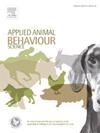Pilot study on the resocialisation of stallions
IF 2.2
2区 农林科学
Q1 AGRICULTURE, DAIRY & ANIMAL SCIENCE
引用次数: 0
Abstract
Under natural conditions, stallions establish stable social groups of two distinct forms: family groups, comprising mares and their young, and bachelor groups, composed entirely of stallions. However, in domestic conditions, stallions are most commonly housed in individual stables, a system that stands in stark contrast to group living, and considerably curtails social contact. One of the main reasons for this choice is related to the fear of injuries during social interactions. However, this type of housing has detrimental effects on both health and welfare. In addition, prolonged isolation may weaken stallions' social skills, creating a vicious cycle: the more they are isolated, the more their social skills deteriorate, reducing their chances of reintegration into a social environment that is crucial for their health and welfare. Therefore, the aim of this study was to investigate the effects of isolation on the social skills of socially deprived stallions and the effectiveness of a gradual protocol to enable a transition from individual housing to group living. We collected the agonistic, affiliative, and ritual/investigative interactions of six stallions during a two-month stepwise protocol. The stallions first met at a distance, followed by a phase in which three pairs were gradually reinforced, ultimately leading to the formation of a group comprising all individuals. At each step, agonistic and ritual/investigative interactions decreased over time. Additionally, affiliative interactions were observed between the stallions from the initial steps of contact, and affinities developed, notably among one pair of individuals. Nevertheless, one individual exhibited a lack of social skills, suggesting that resocialisation may not be feasible for all individuals. The findings of this study indicate that through a gradual familiarisation process, it is possible to facilitate a secure transition from individual housing to group living, thereby providing conditions that are more respectful of the species' needs. This research also provides insights into identifying precursor signs of social skills to determine individuals unfit for resocialisation through this approach. To avoid the challenges of resocialising and managing individuals with poor social skills, it seems essential to change breeding practices by prioritising housing systems that allow for regular social contact.
求助全文
约1分钟内获得全文
求助全文
来源期刊

Applied Animal Behaviour Science
农林科学-行为科学
CiteScore
4.40
自引率
21.70%
发文量
191
审稿时长
18.1 weeks
期刊介绍:
This journal publishes relevant information on the behaviour of domesticated and utilized animals.
Topics covered include:
-Behaviour of farm, zoo and laboratory animals in relation to animal management and welfare
-Behaviour of companion animals in relation to behavioural problems, for example, in relation to the training of dogs for different purposes, in relation to behavioural problems
-Studies of the behaviour of wild animals when these studies are relevant from an applied perspective, for example in relation to wildlife management, pest management or nature conservation
-Methodological studies within relevant fields
The principal subjects are farm, companion and laboratory animals, including, of course, poultry. The journal also deals with the following animal subjects:
-Those involved in any farming system, e.g. deer, rabbits and fur-bearing animals
-Those in ANY form of confinement, e.g. zoos, safari parks and other forms of display
-Feral animals, and any animal species which impinge on farming operations, e.g. as causes of loss or damage
-Species used for hunting, recreation etc. may also be considered as acceptable subjects in some instances
-Laboratory animals, if the material relates to their behavioural requirements
 求助内容:
求助内容: 应助结果提醒方式:
应助结果提醒方式:


